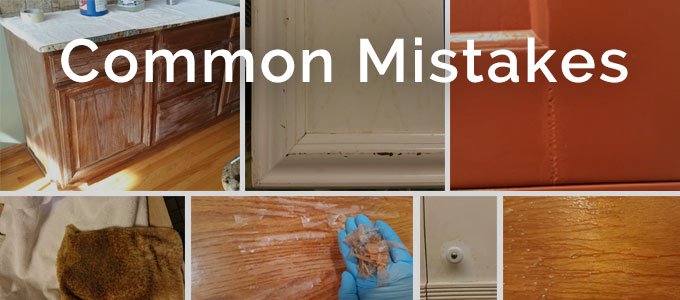
D.I.Y. FOLKS PLEASE BEWARE
Here are some dangers and common mistakes made when do it yourself cabinet refinishing goes wrong.
Take caution, please don’t ruin your cabinets!
Using the wrong cleaning products
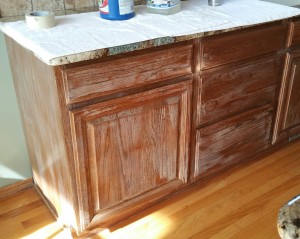
There are a number of popular cabinet cleaning products readily available in stores including oil soap, various lemon oils, furniture waxes and other rejuvenating products (name brands excluded). Most all of these shiny, oily, potentially stinky, and not to mention flammable, products contain petroleum distillates which in turn soften original finishes, thus accelerating decay. After use cabinets may look better; however, these results are temporary. Since these products are oil-based, they leave a film wherever applied which attracts dust and residue. After several cleanings, this build up will dull finishes, and hide the wood grain. Application of multiple products may result in further complications (see pictures #1 ).
Cabinets are wood with the finish on top of them just like your car is metal with a finish on it. If you wouldn’t feel comfortable putting a product on your car, perhaps you should reconsider putting it on your woodwork. Have you ever heard of anyone oiling their car finish? Similar to a clear coat on a car, finished cabinets do not require re-oiling. Only unfinished wood benefits from periodic oiling. (Some would say my wood looks dry. Actually, that's probably your finish breaking down. It needs restoration, that's what we do.) Without intentionally discrediting any name brand products, keep in mind that there is a lot of “snake oil” out there for sale.
Avoid using abrasive cleaners, steel wool, and rough scrubbing pads. Monthly insecticide spraying will also eventually damage your lacquered baseboards!
Using the wrong finish
Many DIY cabinet refinishing projects don’t end well! Often times D.I.Y.er's are advised to use an oil-based polyurethane; however, the polys recommended by clerks at a home improvement store are not always the ideal product for the job. This mistake is commonly made because the products used to finish raw wood often are not ideal for bonding to preexisting finishes. Please be aware, and avoid a disastrous chemical reaction that may result in sheets of finish peeling off your cabinets (See Pictures #2 & #3).
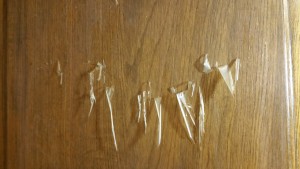
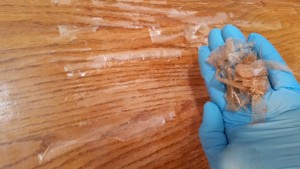
Improper preparation
One of the most important steps to any refinishing project is proper preparation. People often hastily apply a finish without properly cleaning and staining damaged areas of the woodwork first. The results of improper preparation include permanently sealed in the dirt, grime, damage and perhaps the wrong stain color.
Colored finishes and finish over products
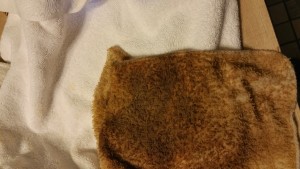
There are many products sold, including tinted poly, waxes and stains, designed to change the color of cabinets; however, they have pitfalls. These products may streak, peel off, leave disproportionate coloration when applied over original finishes and even wash off with common cleaning products.
Even though most of these are distributed by reputable companies, they have a tendency to create a horrible mess (See Picture #4 and bottom right picture in the photo collage at the top of this page).
Paint issues
Factory painted cabinets are absolutely beautiful, so many people attempt to replicate them by painting over their stained cabinets. Unfortunately, cabinets are often ruined by using the wrong paint products and processes. Common wall paint will not properly adhere to cabinets and will peel off. (see Picture # 5)
Cabinet-rated paints come too thick and have to be properly thinned to work with a brush or spray unit. Clearly visible brush marks everywhere are not the mark of beautiful craftsmanship and are evidence the paint was not properly thinned.
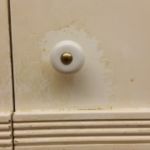
Oak and other common woods will show all the grain patterns right through the paint. (see picture # 7) This may be displeasing to prospective home buyers. Remember, it’s impossible to strip all the paint off and return to stained wood, so there’s no going back!
Lacquer paint is too brittle and will crack at the joints and easily chip. (see picture #6)
If you must paint we recommend Kitchen Concepts in Nixa Missouri, they use an acrylic polyurethane that will last for several decades.
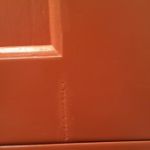
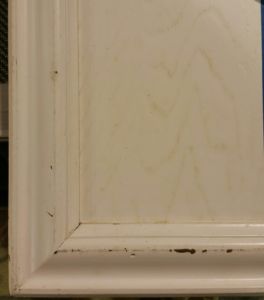
Many professional painters are not cabinet experts.
Cabinets painted with lacquer paint are often aesthetically pleasing; however, some lacquer products are too brittle. These products are very hard and will not expand or contract with wood over time. This results in chipping and cracks at joints and other various places. (see picture # 6) This is an example of a mistake often made by professional painters not properly trained on what works best for cabinets.
The center panel on cabinet doors needs to be free to move a little to compensate for seasonal changes. An inexperienced cabinet painter may caulk this joint resulting in unsightly and irreparable large cracks that will appear in a few months.
I hope it's been an interesting read and worth your time, most of all I hope I've saved you and your cabinets from some of the most common refinishing mistakes.
If you value your home always thoroughly check out your contractor with your BBB, HBA and various other review sites!
